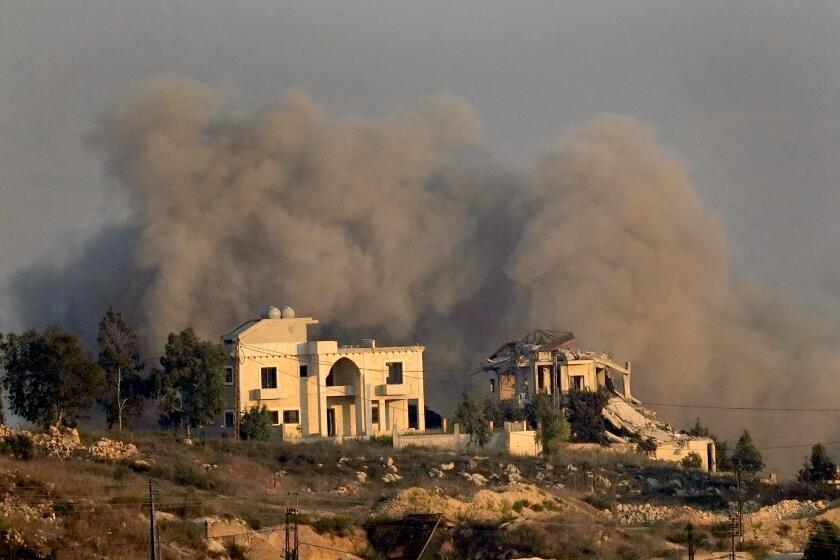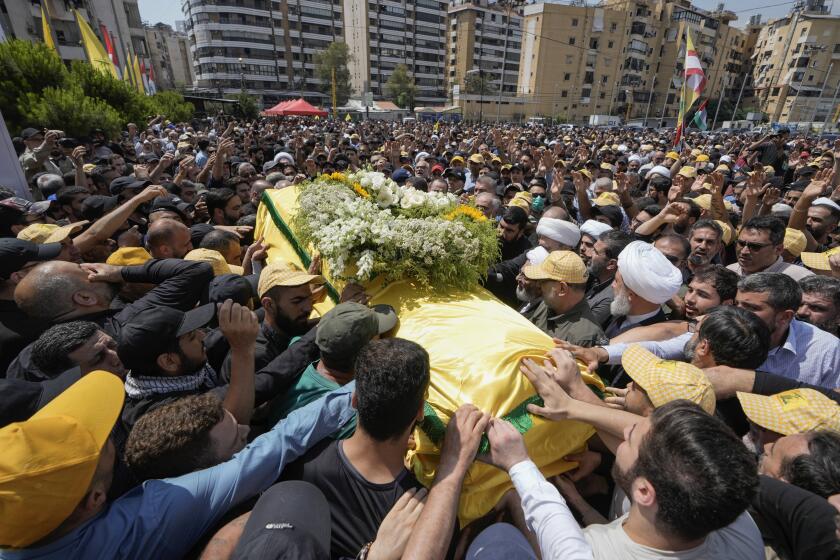Israel tells its troops to prepare for a possible ground operation in Lebanon

- Share via
TEL AVIV — Israel is preparing for a possible ground operation in Lebanon, its army chief said Wednesday as Hezbollah fired dozens of rockets across the border and a missile aimed at Tel Aviv that was the militant group’s deepest strike yet.
Addressing troops on the northern border, Chief of Staff Lt. Gen. Herzi Halevi said Israel’s punishing airstrikes this week were designed to ”prepare the ground for your possible entry and to continue degrading Hezbollah.”
Israel says it targeted Hezbollah weapons and rocket launchers in attacks that have killed more than 600 people, at least a quarter of them women and children, according to Lebanese health officials.
In an apparent reference to the missile fired at Tel Aviv, Halevi told troops: “Today, Hezbollah expanded its range of fire, and later today, they will receive a very strong response. Prepare yourselves.”
It was unclear whether he was referring to a ground operation, airstrikes or some other form of retaliation against Hezbollah, which is Lebanon’s strongest political force and, with backing from Iran, is widely considered the top paramilitary group in the Arab world.
Hezbollah, the Lebanese Shiite militant group backed by Iran, appears to have hit the lowest point in its more than 40-year history.
The Israeli military has said in recent days it had no immediate plans for a ground invasion, but Halevi’s comments were the strongest yet suggesting troops could move in. Israel said Wednesday that it would activate two reserve brigades for missions in the north — another sign that it plans tougher action.
In the southern Israeli city of Eilat, a building at the port was struck by a drone, an attack that injured two people and was claimed by an umbrella group for Iranian-backed militias in Iraq. A second drone was intercepted, the Israeli military said.
Video aired on Israeli media showed a plume of smoke in the area and at least one damaged building. The army said the drones were identified “approaching from the east.”
Tensions between Israel and Hezbollah have steadily escalated since war broke out 11 months ago between Israel and Hamas, another Iran-backed militant group. Hezbollah has been firing rockets, missiles and drones into northern Israel in solidarity with Hamas and Palestinians in Gaza. Israel has responded with increasingly heavy airstrikes and the targeted killing of Hezbollah commanders while threatening a wider operation.
Nearly a year of fighting had already displaced tens of thousands of people on both sides of the border before the recent escalation.
The conflict between U.S.-backed Israel and Iran-backed Hezbollah could reach unprecedented levels of danger and destruction if it becomes all-out war.
Israel has vowed to do whatever it takes to ensure its citizens can return to their homes in the north, while Hezbollah has said it will keep up its rocket attacks until there is a cease-fire in Gaza, something that appears increasingly remote.
To allow displaced Israelis to return to their homes, “we are preparing the process of a maneuver,” Halevi told troops.
U.S. Secretary of State Antony J. Blinken urged Israel and Hezbollah to step back, saying all-out war would be disastrous for the region and its people.
In New York for the annual U.N. General Assembly, Blinken said the U.S. was working with other partners on a temporary cease-fire plan to reduce tensions and allow Israelis and Lebanese to return to their homes in border areas.
U.S. officials say they are floating ideas but have not been specific. Some may be discussed at a special U.N. Security Council meeting on Lebanon that France called for Wednesday.
Lebanon’s health minister said more than 50 people were killed Wednesday in the continuing Israeli strikes, raising the death toll from the last three days to 615, with more than 2,000 wounded.
Israel said it hit more than 1,110 Hezbollah targets in Lebanon. Lebanese officials said 492 people were killed.
At Dar Al Amal hospital in the eastern city of Baalbek, Soumaya Moussawi lay in bed with her head bandaged and face bruised.
She had been sitting outside with relatives when warplanes started striking in the distance, she said.
“Then suddenly it hit next to us. We were all thrown in different directions,” she said. Two cousins and her father were killed, and another cousin was badly wounded.
This week has been the deadliest in Lebanon since the bruising 2006 monthlong war between Israel and Hezbollah.
Hezbollah said it fired a Qader 1 ballistic missile targeting the headquarters of Israel’s Mossad intelligence agency, which it blames for a recent string of targeted killings of its top commanders and for an attack last week in which explosives hidden in pagers and walkie-talkies killed dozens of people and wounded thousands, including many Hezbollah members.
Israeli military officials said they intercepted a surface-to-surface missile that set off air-raid sirens in Tel Aviv and across central Israel. There were no reports of casualties or damage. The military said it struck the launch site in southern Lebanon.
Pentagon press secretary Maj. Gen. Pat Ryder would provide no details on how many additional forces or what they would be tasked to do.
Israeli military spokesman Lt. Col. Nadav Shoshani said the missile fired Wednesday had a “heavy warhead” but declined to elaborate or confirm it was the type described by Hezbollah. He dismissed Hezbollah’s claim of targeting the Mossad headquarters just north of Tel Aviv as “psychological warfare.”
The Israeli military said it was the first time a projectile fired from Lebanon had reached central Israel. Hezbollah claimed to have targeted an intelligence base near Tel Aviv last month in an aerial attack, but there was no confirmation. Hamas repeatedly targeted Tel Aviv in the opening months of the war in Gaza.
The launch ratcheted up hostilities in a region that appeared to be teetering toward another all-out war, even as Israel continues to battle Hamas in the Gaza Strip.
The Iranian-made Qader is a medium-range surface-to-surface ballistic missile with multiple types and payloads. It can carry an explosive payload of up to 1,760 pounds, according to the Washington-based Center for Strategic and International Studies. Iranian officials have described the liquid-fueled missile as having a range of 1,240 miles.
Israel said Wednesday its air force had struck about 280 Hezbollah targets across Lebanon by early afternoon.
Fleeing families have flocked to Beirut and the coastal city of Sidon, sleeping in schools turned into shelters, as well as in cars, at parks and along the beach. Some sought to leave the country, causing a traffic jam at the border with Syria.
The United Nations said more than 90,000 people have been displaced by five days of Israeli strikes. In all, 200,000 people have been displaced in Lebanon since Hezbollah began firing rockets into northern Israel nearly a year ago, drawing Israeli retaliation, according to the U.N. Office for the Coordination of Humanitarian Affairs.
Deadly sabotage of pagers used by militant group Hezbollah is widely blamed on Israel — but what was attack’s real aim?
Hezbollah’s latest strikes included dozens of rockets fired Wednesday into northern Israel, the military said.
Rocket fire over the last week has disrupted life for more than 1 million people across northern Israel, with schools closed and public gatherings restricted. Many restaurants and other businesses are shuttered in the coastal city of Haifa, and there are fewer people on the streets. Some who fled from communities near the border are coming under rocket fire again.
Israel has moved thousands of troops who had been serving in Gaza to the northern border. It says Hezbollah has about 150,000 rockets and missiles, including some capable of striking anywhere in Israel.
Cross-border fire began ramping up Sunday after pagers and walkie-talkies used by Hezbollah were attacked remotely, killing 39 people and wounded nearly 3,000, many of them civilians. Lebanon blamed Israel, which has not confirmed or denied responsibility.
The next day, Israel said, its warplanes struck 1,600 Hezbollah targets, destroying cruise missiles, long- and short-range rockets and attack drones, including weapons concealed in private homes. The strikes racked up the highest one-day death toll in Lebanon since the 2006 war.
Lidman, Goldenberg and Chehayeb write for the Associated Press. Chehayeb reported from Beirut. AP writers Suleiman Amhaz in Baalbek and Jon Gambrell in Dubai contributed to this report.
More to Read
Sign up for Essential California
The most important California stories and recommendations in your inbox every morning.
You may occasionally receive promotional content from the Los Angeles Times.















